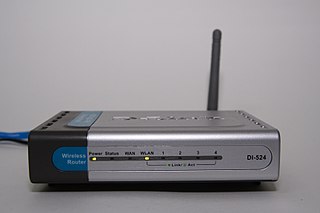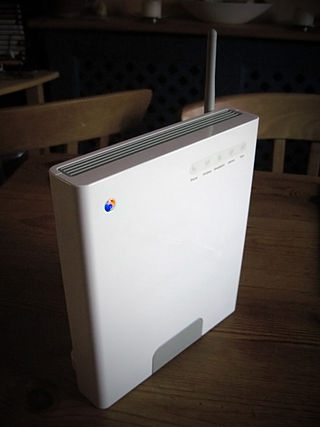Cell most often refers to:

IEEE 802.11 is part of the IEEE 802 set of local area network (LAN) technical standards, and specifies the set of medium access control (MAC) and physical layer (PHY) protocols for implementing wireless local area network (WLAN) computer communication. The standard and amendments provide the basis for wireless network products using the Wi-Fi brand and are the world's most widely used wireless computer networking standards. IEEE 802.11 is used in most home and office networks to allow laptops, printers, smartphones, and other devices to communicate with each other and access the Internet without connecting wires. IEEE 802.11 is also a basis for vehicle-based communication networks with IEEE 802.11p.
A MAC address is a unique identifier assigned to a network interface controller (NIC) for use as a network address in communications within a network segment. This use is common in most IEEE 802 networking technologies, including Ethernet, Wi-Fi, and Bluetooth. Within the Open Systems Interconnection (OSI) network model, MAC addresses are used in the medium access control protocol sublayer of the data link layer. As typically represented, MAC addresses are recognizable as six groups of two hexadecimal digits, separated by hyphens, colons, or without a separator.

A wireless LAN (WLAN) is a wireless computer network that links two or more devices using wireless communication to form a local area network (LAN) within a limited area such as a home, school, computer laboratory, campus, or office building. This gives users the ability to move around within the area and remain connected to the network. Through a gateway, a WLAN can also provide a connection to the wider Internet.
Sic, as the label "[sic]" found immediately following a copy of text, indicates that a use that may seem erroneous is in fact transcribed faithfully.

Wi-Fi is a family of wireless network protocols based on the IEEE 802.11 family of standards, which are commonly used for local area networking of devices and Internet access, allowing nearby digital devices to exchange data by radio waves. These are the most widely used computer networks, used globally in home and small office networks to link devices and to provide Internet access with wireless routers and wireless access points in public places such as coffee shops, hotels, libraries, and airports to provide visitors.

Wireless communication is the transfer of information (telecommunication) between two or more points without the use of an electrical conductor, optical fiber or other continuous guided medium for the transfer. The most common wireless technologies use radio waves. With radio waves, intended distances can be short, such as a few meters for Bluetooth or as far as millions of kilometers for deep-space radio communications. It encompasses various types of fixed, mobile, and portable applications, including two-way radios, cellular telephones, personal digital assistants (PDAs), and wireless networking. Other examples of applications of radio wireless technology include GPS units, garage door openers, wireless computer mouse, keyboards and headsets, headphones, radio receivers, satellite television, broadcast television and cordless telephones. Somewhat less common methods of achieving wireless communications involve other electromagnetic phenomena, such as light and magnetic or electric fields, or the use of sound.

A wireless router or Wi-Fi router is a device that performs the functions of a router and also includes the functions of a wireless access point. It is used to provide access to the Internet or a private computer network. Depending on the manufacturer and model, it can function in a wired local area network, in a wireless-only LAN, or in a mixed wired and wireless network.

Wireless Festival is an annual rap and hip-hop music festival that takes place in London, England. It is owned and managed by Live Nation. While it started as primarily a rock and pop festival, since the early 2010s, it has focused on hip-hop and other genres of music.

The Game Boy Advance Wireless Adapter is a wireless adapter accessory for the Game Boy Advance, released by Nintendo in 2004. It provides an alternative to the Game Boy Advance Game Link Cable but is only supported by a small number of games. The Game Boy Advance Wireless Adapter is also compatible with the Game Boy Advance SP, Game Boy Player, and e-Reader.
Super G is a proprietary method to increase the throughput of an IEEE 802.11g (Wi-Fi) wireless LAN. Atheros uses frame-bursting, compression, and channel bonding technology to improve performance. The throughput transmission speed limit when using Super G is claimed to be up to 40 Mbit/s-60 Mbit/s at a 108 Mbit/s signaling rate, which is achieved through the bonding of two 54 Mbit/s 802.11g channels.
This is a list of video game accessories that have been released for the Game Boy handheld console and its successors. Accessories add functionality that the console would otherwise not have.
The DG834 series are popular ADSL modem router products from Netgear. The devices can be directly connected to the phone line and establish an ADSL broadband Internet connection to the ISP and share it among several computers via 802.3 Ethernet and 802.11b/g wireless data links.
Frame-bursting is a communication protocol feature used at the link layer in communication networks to alter the transmission characteristics in order to benefit from higher throughput. It is a technique sometimes used in communication protocols for shared mediums to achieve higher throughput by allowing the transmitter to send a series of frames in succession without relinquishing control of the transmission medium. Related techniques used to achieve the same goal include fast frames wherein the inter-frame wait interval is reduced, and jumbo frames wherein the size of the frame is increased. Frame bursting may also benefit from packet aggregation. Communication protocols for shared mediums are designed to relinquish the medium and wait for a while after the transmission of a MAC layer frame in order to facilitate the fair use of the medium by multiple users. Frame bursting may be permissible in certain scenarios such as when the link is point-to-point or when the signal from other users is indistinguishable from noise. Frame bursting allows for more data packets per time interval at the cost of wait time for other users.

The BT Smart Hub is a family of wireless residential gateway router modems distributed by BT for use with their own products and services and those of wholesale resellers but not with other Internet services. Since v 5 Home/Smart Hubs support the faster Wi-Fi 802.11ac standard, in addition to the 802.11b/g/n standards. All models of the Home Hub prior to Home Hub 3 support VoIP Internet telephony via BT's Broadband Talk service, and are compatible with DECT telephone handsets. Since the Home Hub 4, all models have been dual band.
IEEE 802.11g-2003 or 802.11g is an amendment to the IEEE 802.11 specification that operates in the 2.4 GHz microwave band. The standard has extended link rate to up to 54 Mbit/s using the same 20 MHz bandwidth as 802.11b uses to achieve 11 Mbit/s. This specification under the marketing name of Wi-Fi has been implemented all over the world. The 802.11g protocol is now Clause 19 of the published IEEE 802.11-2007 standard, and Clause 19 of the published IEEE 802.11-2012 standard.
Republic Wireless was an American mobile virtual network operator (MVNO). Republic sold low cost mobile phone service on partner networks. Republic started as a unique company that provided customers with VOIP numbers which relied on WiFi first with cell as a backup.







